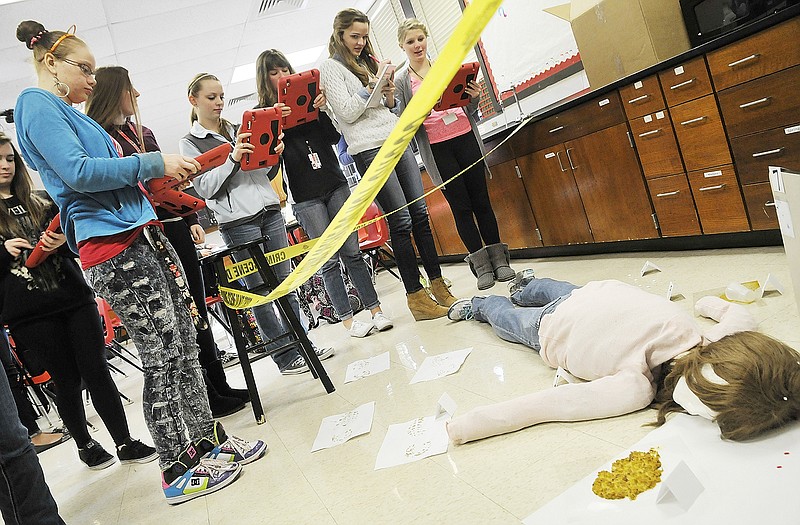Who killed Anna Garcia?
Was it a murder? A suicide? Or did she simply die from an untreated medical condition?
As Simonsen 9th Grade Center students returned from winter break on Monday, they found a mystery waiting for them in Keith Loftin's Principles of Biomedical Science classroom.
On the floor was a figure - the fictional body of Anna Garcia - surrounded by clues to her demise. Throughout the remainder of the semester, students will examine those "clues"- which ranged from shoe prints to an unappetizing pool of vomit - using forensic scientific techniques to unravel the mystery.
"We use them (the clues) as the basis to figure out how she died," Loftin said.
Over the next five months, the teens will investigate various health conditions including heart and sickle-cell disease, diabetes and other infectious diseases. They will determine the factors that led to Garcia's death and they will investigate lifestyle choices and medical treatments that might have prolonged her life.
The activities will introduce students to human physiology, medicine and other research processes.
Students enrolled in the course are members of the Health Services Academy, one of seven career-oriented academies launched last fall in an effort to make the district's academic offerings more relevant and more rigorous.
The curriculum was designed by Project Lead the Way, a non-profit organization that seeks to prepare students for the global economy by emphasizing the "STEM" subjects, also known as science, technology, engineering and math.
Project Lead the Way was launched in 1997 in upstate New York to address a shortage of engineering students at the college level. In Missouri the program is headquartered in Rolla on the Missouri University of Science and Technology campus.
Although the mystery remains the same from year to year, the exact cause of Garcia's death changes every semester to keep the surprise fresh for students.
On Monday, as the students surrounded the "crime scene," they tried to absorb and remember what they were seeing.
"Take as many pictures as you want. Jot as many things down as you can," Loftin advised.
Loftin said the mystery serves to engage students in the academic work ahead of them. As they work to solve it, they'll also be learning scientific concepts such as DNA, cell structure and genetics.
"They will be doing more real-world science than I've every taught in class before," he said.
Before moving into a description of the course's syllabus, Loftin prompted listeners to chat about what they'd already noticed. Some of the kids mentioned that furniture had been tipped over. Others noticed pills were spilled at the scene, but they didn't know if they were vitamins or something more sinister.
"I can tell you, most of the questions you guys are asking are good questions," Loftin said. "You are asking the right questions. But I'm never going to tell you what happened.
"You will figure it out," he promised.
As the course started, Loftin asked the teens to ponder what it means to be scientific. And he asked them to create a concept map showing they understood the steps investigators use to solve crimes.
He also said the course is going to be challenging, and suggested they will have to study 30 minutes several times a week to excel. Students who perform well in the class will be eligible for college credit.
"Even if you don't go into a career in biology or medicine, you'll still be learning things that relate to your everyday life," he said.
Emma Hull, 15, said she thinks the class is going to be fascinating.
"I find all this stuff so interesting," Hull said, noting she has a "nerdy side" and is keen to explore the causes and reactions that lead to Garcia's demise.
"Everyone I've talked to, it's been their favorite class," she said.
Thomas McCarthy, 15, also was enthusiastic.
"I like how we have to find out the information for ourselves," he said. "I'm really excited for this class."
Whether his group ends up solving the crime or simply clarifying a medical mystery, McCarthy said he didn't care.
"However this ends, I'm just going to be happy that I've learned things I didn't know before. I feel like I'm going to be more satisfied with what I've learned," he said.

